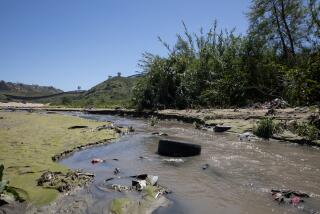Town Is Laboratory for Chemical Hazards
DAYHOIT, Ky. — There’s a reason, one biochemical researcher says, why no significant epidemiological study has been done on industrial pollution in this southeastern Kentucky community: People here aren’t dying quickly enough.
“That’s the bottom line. That’s the only way people become interested,” said Dr. Ralph Magnotti Jr., an assistant professor of medicine at the University of Cincinnati.
Magnotti has taken an interest in the plight of the contamination-plagued Harlan County town, and he is using a new technology that he developed.
Hazardous amounts of vinyl chloride, a carcinogen, turned up in groundwater tested near Dayhoit’s Holiday Mobile Home Park in February, 1989. Later, heavy concentrations of PCBs, which also can cause cancer, were found in the soil at the nearby National Coil-National Electric plant.
PCBs in lesser concentrations also were found in the mobile home park, and further water testing found that at least 14 other private wells within a mile of the plant site were contaminated.
Cooper Industries of Houston, a former owner of the site, has offered to clean it up. Much soil and many barrels of chemicals have been removed. The area is expected to be named on a priority list of Superfund sites soon to be released by the U.S. Environmental Protection Agency.
In February, 1990, more than 200 residents and former employees of the plant filed a $300-million lawsuit against Cooper. They have been waiting since October for a federal judge to decide whether it qualifies as a class action.
Magnotti is working with the people of Dayhoit on a “health surveillance monitoring program.” He is looking for signs of kidney damage, an indicator of overexposure to chemicals.
Such studies have been done before, but, Magnotti said, none has used a whole community as the laboratory.
“They usually involve groups of workers who are, essentially, locked in a factory for 10 years,” he said.
Most workers in previous studies were exposed to extremely high levels of toxins, he said. Exposure to a community’s environment is not so easy to study, he said.
“The key word here is publishable ,’ ” he said. “Most of the people who do studies need to have work that is publishable under peer review. (Findings) need to be dramatic and clear cut.”
The contamination discovered in Dayhoit is believed to have accumulated between 1951 and 1987, from degreasing fluids and other materials used over the years at the coil plant.
Magnotti said the substances in question are “not very acutely toxic, but they are fairly potent carcinogens--and cancer doesn’t develop overnight.”
Joan Robinett, who lived for three years in the mobile home park, has been leading local efforts to assist the study.
“We’re doing the documentation and the legwork,” said Robinett, who heads Concerned Citizens Against Toxic Waste.
Townspeople also are keeping journals and logging statistics about their lives and state of health, said Roy Silver, the Southeast Community College sociology professor who introduced Magnotti to Robinett.
The study group will number 300 people, including about 250 Dayhoit residents, of whom 100 worked at the coil plant, Robinett said. The other 50 subjects will be chosen from a neighboring area and will form a control group not exposed to the chemicals, Magnotti said. He will not know who was exposed and who wasn’t.
The test Magnotti will use to detect kidney damage is called enzyme-linked immunolsorbent assay. It measures kidney function and also detects AIDS, hepatitis and other diseases, he said.
Magnotti said he developed two new versions of the kidney assay while studying the effects of pesticide exposure on people who worked with the World Heath Organization in Nicaragua. These tests show up certain molecules that indicate the earliest stages of kidney disease.
His work is being supported by a $10,000 grant from the Needmor Fund of Boulder, Colo.
Robinett said the study, due to be completed this month, “is not something that will hold up in court.” But Magnotti said the data will lay the groundwork for future claims involving entire communities exposed to toxins.
More to Read
Sign up for Essential California
The most important California stories and recommendations in your inbox every morning.
You may occasionally receive promotional content from the Los Angeles Times.









